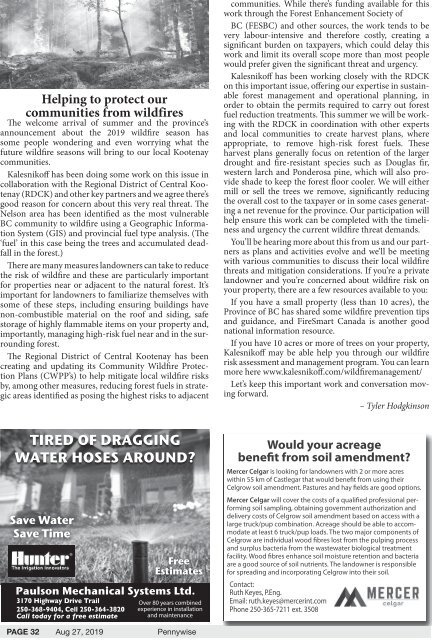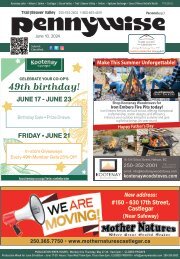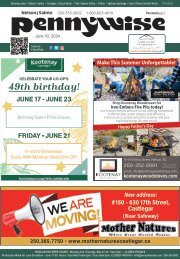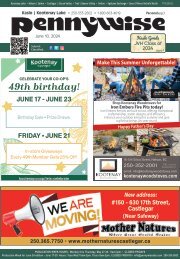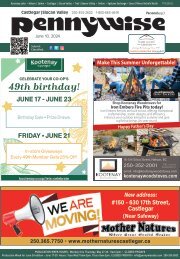Aug 27, Pennywise – Trail, Beaver Valley, Rossland
Complete coverage of Trail, Rossland, Fruitvale, Montrose.
Complete coverage of Trail, Rossland, Fruitvale, Montrose.
Create successful ePaper yourself
Turn your PDF publications into a flip-book with our unique Google optimized e-Paper software.
Helping to protect our<br />
communities from wildfires<br />
The welcome arrival of summer and the province’s<br />
announcement about the 2019 wildfire season has<br />
some people wondering and even worrying what the<br />
future wildfire seasons will bring to our local Kootenay<br />
communities.<br />
Kalesnikoff has been doing some work on this issue in<br />
collaboration with the Regional District of Central Kootenay<br />
(RDCK) and other key partners and we agree there’s<br />
good reason for concern about this very real threat. The<br />
Nelson area has been identified as the most vulnerable<br />
BC community to wildfire using a Geographic Information<br />
System (GIS) and provincial fuel type analysis. (The<br />
‘fuel’ in this case being the trees and accumulated deadfall<br />
in the forest.)<br />
There are many measures landowners can take to reduce<br />
the risk of wildfire and these are particularly important<br />
for properties near or adjacent to the natural forest. It’s<br />
important for landowners to familiarize themselves with<br />
some of these steps, including ensuring buildings have<br />
non-combustible material on the roof and siding, safe<br />
storage of highly flammable items on your property and,<br />
importantly, managing high-risk fuel near and in the surrounding<br />
forest.<br />
The Regional District of Central Kootenay has been<br />
creating and updating its Community Wildfire Protection<br />
Plans (CWPP’s) to help mitigate local wildfire risks<br />
by, among other measures, reducing forest fuels in strategic<br />
areas identified as posing the highest risks to adjacent<br />
communities. While there’s funding available for this<br />
work through the Forest Enhancement Society of<br />
BC (FESBC) and other sources, the work tends to be<br />
very labour-intensive and therefore costly, creating a<br />
significant burden on taxpayers, which could delay this<br />
work and limit its overall scope more than most people<br />
would prefer given the significant threat and urgency.<br />
Kalesnikoff has been working closely with the RDCK<br />
on this important issue, offering our expertise in sustainable<br />
forest management and operational planning, in<br />
order to obtain the permits required to carry out forest<br />
fuel reduction treatments. This summer we will be working<br />
with the RDCK in coordination with other experts<br />
and local communities to create harvest plans, where<br />
appropriate, to remove high-risk forest fuels. These<br />
harvest plans generally focus on retention of the larger<br />
drought and fire-resistant species such as Douglas fir,<br />
western larch and Ponderosa pine, which will also provide<br />
shade to keep the forest floor cooler. We will either<br />
mill or sell the trees we remove, significantly reducing<br />
the overall cost to the taxpayer or in some cases generating<br />
a net revenue for the province. Our participation will<br />
help ensure this work can be completed with the timeliness<br />
and urgency the current wildfire threat demands.<br />
You’ll be hearing more about this from us and our partners<br />
as plans and activities evolve and we’ll be meeting<br />
with various communities to discuss their local wildfire<br />
threats and mitigation considerations. If you’re a private<br />
landowner and you’re concerned about wildfire risk on<br />
your property, there are a few resources available to you:<br />
If you have a small property (less than 10 acres), the<br />
Province of BC has shared some wildfire prevention tips<br />
and guidance, and FireSmart Canada is another good<br />
national information resource.<br />
If you have 10 acres or more of trees on your property,<br />
Kalesnikoff may be able help you through our wildfire<br />
risk assessment and management program. You can learn<br />
more here www.kalesnikoff.com/wildfiremanagement/<br />
Let’s keep this important work and conversation moving<br />
forward.<br />
<strong>–</strong> Tyler Hodgkinson<br />
TIRED OF DRAGGING<br />
WATER HOSES AROUND?<br />
Save Water<br />
Save Time<br />
Paulson Mechanical Systems Ltd.<br />
3170 Highway Drive <strong>Trail</strong><br />
250-368-9404, Cell 250-364-3820<br />
Call today for a free estimate<br />
Free<br />
Estimates<br />
Over 80 years combined<br />
experience in installation<br />
and maintenance<br />
Would your acreage<br />
benefit from soil amendment?<br />
Mercer Celgar is looking for landowners with 2 or more acres<br />
within 55 km of Castlegar that would benefit from using their<br />
Celgrow soil amendment. Pastures and hay fields are good options.<br />
Mercer Celgar will cover the costs of a qualified professional performing<br />
soil sampling, obtaining government authorization and<br />
delivery costs of Celgrow soil amendment based on access with a<br />
large truck/pup combination. Acreage should be able to accommodate<br />
at least 6 truck/pup loads. The two major components of<br />
Celgrow are individual wood fibres lost from the pulping process<br />
and surplus bacteria from the wastewater biological treatment<br />
facility. Wood fibres enhance soil moisture retention and bacteria<br />
are a good source of soil nutrients. The landowner is responsible<br />
for spreading and incorporating Celgrow into their soil.<br />
Contact:<br />
Ruth Keyes, P.Eng.<br />
Email: ruth.keyes@mercerint.com<br />
Phone 250-365-7211 ext. 3508<br />
PAGE 32 <strong>Aug</strong> <strong>27</strong>, 2019 <strong>Pennywise</strong>


